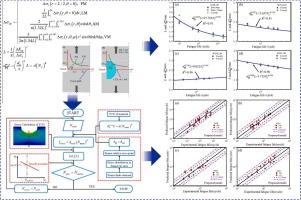Quantitative assessment of notch fatigue behavior in Mg-RE alloys via zero-point critical distance theory
IF 6.8
2区 材料科学
Q1 ENGINEERING, MECHANICAL
引用次数: 0
Abstract
Notched fatigue tests were conducted at room temperature on three Mg-Y-Zn alloys with varying initial contents of long-period stacking ordered (LPSO) phases. The influence of the notch effect on the fatigue life of these alloys was analyzed. The results indicate that the notch effect significantly reduces the fatigue life of the Mg-Y-Zn alloys, with a higher stress concentration factor correlating to shorter fatigue lives. Under high-stress conditions, the fatigue life of the identical notched specimens decreases as the LPSO phase content increases. Conversely, under low-stress conditions, the fatigue life of the notched specimen tends to increase with rising LPSO phase content. Notably, when compared to parameters such as stress concentration factor, high-stress volume, and relative stress gradient, the relative zero-point parameter provides a more straightforward analytical approach and enables precise notch characterization. A novel zero-point critical distance (ZPCD) model is proposed by incorporating the relative zero-point parameter into the classical TCD framework. Experimental validation demonstrates that the ZPCD model achieves significantly higher prediction accuracy for notch fatigue performance than the traditional TCD method.

基于零点临界距离理论的Mg-RE合金缺口疲劳行为定量评价
对三种初始长周期有序堆积相(LPSO)含量不同的Mg-Y-Zn合金进行了室温缺口疲劳试验。分析了缺口效应对合金疲劳寿命的影响。结果表明:缺口效应显著降低Mg-Y-Zn合金的疲劳寿命,应力集中系数较高,疲劳寿命较短;在高应力条件下,相同缺口试样的疲劳寿命随着LPSO相含量的增加而降低。相反,在低应力条件下,缺口试样的疲劳寿命随着LPSO相含量的增加而增加。值得注意的是,与应力集中系数、高应力体积和相对应力梯度等参数相比,相对零点参数提供了更直接的分析方法,并能够精确表征缺口。将相对零点参数引入到经典的零点临界距离框架中,提出了一种新的零点临界距离模型。实验验证表明,ZPCD模型对缺口疲劳性能的预测精度明显高于传统的TCD方法。
本文章由计算机程序翻译,如有差异,请以英文原文为准。
求助全文
约1分钟内获得全文
求助全文
来源期刊

International Journal of Fatigue
工程技术-材料科学:综合
CiteScore
10.70
自引率
21.70%
发文量
619
审稿时长
58 days
期刊介绍:
Typical subjects discussed in International Journal of Fatigue address:
Novel fatigue testing and characterization methods (new kinds of fatigue tests, critical evaluation of existing methods, in situ measurement of fatigue degradation, non-contact field measurements)
Multiaxial fatigue and complex loading effects of materials and structures, exploring state-of-the-art concepts in degradation under cyclic loading
Fatigue in the very high cycle regime, including failure mode transitions from surface to subsurface, effects of surface treatment, processing, and loading conditions
Modeling (including degradation processes and related driving forces, multiscale/multi-resolution methods, computational hierarchical and concurrent methods for coupled component and material responses, novel methods for notch root analysis, fracture mechanics, damage mechanics, crack growth kinetics, life prediction and durability, and prediction of stochastic fatigue behavior reflecting microstructure and service conditions)
Models for early stages of fatigue crack formation and growth that explicitly consider microstructure and relevant materials science aspects
Understanding the influence or manufacturing and processing route on fatigue degradation, and embedding this understanding in more predictive schemes for mitigation and design against fatigue
Prognosis and damage state awareness (including sensors, monitoring, methodology, interactive control, accelerated methods, data interpretation)
Applications of technologies associated with fatigue and their implications for structural integrity and reliability. This includes issues related to design, operation and maintenance, i.e., life cycle engineering
Smart materials and structures that can sense and mitigate fatigue degradation
Fatigue of devices and structures at small scales, including effects of process route and surfaces/interfaces.
 求助内容:
求助内容: 应助结果提醒方式:
应助结果提醒方式:


